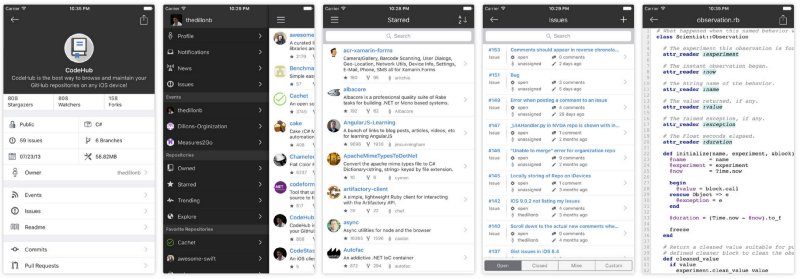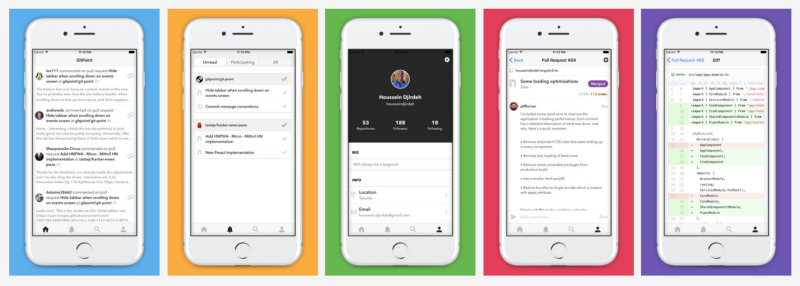by John Lafleur
How To Choose The Right Mobile App For Your GitHub Projects

On GitHub, you now have 1.5 million organizations with 25 million active repositories. That’s an average of 17 active repos per organization! Developers are participating in more and more GitHub projects at the same time. Still, GitHub doesn’t have any official mobile clients. Let’s see why and what mobile app alternatives there are in order to see if there is one you should absolutely get.
Over the past few years, I’ve contributed to the development of two developer platforms — CodinGame and Tech.io. Together they total more than 1M developers. I’ve recently co-founded an Engineering Intelligence platform called Anaxi. Think of it as actionable business intelligence for the whole engineering organization. So part of my job is identifying growing trends in software development tools. In other words, I think about this kind of thing quite a lot!
So let’s first understand why GitHub is not focusing any resources on any mobile clients.
Why would GitHub not build a mobile app?
The basic reasoning for GitHub to even consider building some mobile clients is likely that the value outweighs the cost in their eyes. And there are many ways to approach this.
The first thought that comes to mind: what do you do most on GitHub? Code reviews, code merge, anything around coding. But have you ever coded on mobile? I haven’t. And even if you wanted to make a small change in the code, how would you test the code you modified?
Sure, you might also want to comment on GitHub issues, that’s true. And I think that’s behavior that’s much more likely to happen on a mobile device. Just as it turned out that not every email is serious prose, then not everything that goes on in GitHub is significant programming. Sometimes you just want to make small adjustments to an issue.
But actually, that’s not what is important in this matter. The important question is, does GitHub gain anything by controlling the user interaction? Whether or not you comment on issues from your mobile, you will almost always end up going to their web application for code reviews and merge.
GitHub’s focus has always been to become this inevitable part of the software development process. And to do that, it needed to build a powerful API so that 3rd-party developers could build great user experiences for everything around their versioning service. A mobile client is just part of those user experiences.
Will that change with Microsoft’s acquisition? Maybe. Even before the acquisition, GitHub had recently been building new project management tools. Microsoft is very strong in project management tools. It is actually the world leader in this. Especially if you consider Microsoft Excel as the alternative to everything, like I do! So you might think they would put more resources into bringing the war to Atlassian to try owning engineering project management.
What are we left with now? What are the best alternatives we’ve got on mobile? What are the use cases?
What are some potential mobile apps for your GitHub projects?
If you’re like me, you prefer to compare things in a good old spreadsheet. For this benchmark, I have only focused on what I considered to be the most noteworthy apps. There are actually dozens more. So if you feel this list is missing some other apps that are worthy enough to lift Thor’s hammer, please leave a comment!

Lots of them are delivering the same kind of features. Note that all of them are free. So let’s dive a bit further into each of these apps!
Fasthub (Android)
In my opinion, Fasthub is the best Android mobile client if you’re looking into having all GitHub’s features on your phone. It has a customizable theme and a very clean UI. Fasthub’s user experience focuses on Feeds (understand Notifications from all your projects), Issues, and Pull Requests. This coincides with your main current use cases for GitHub. Fasthub is still actively developed, in contrast to most other Android clients.

OctoDroid & Forkhub (Android)
They stand for the most downloaded GitHub Android clients made by individuals and not developed upon anymore — there are a lot of apps like this.
In comparison to Fasthub, it seems they just wanted to reproduce Github’s features without thinking of our use cases. It doesn’t have any customizable theme. But still, they are feature complete.


CodeHub (iPhone / iPad)
CodeHub is the iOS GitHub client that offers all GitHub features in a brick-after-brick interface and functional UI. The app structure is not adapted to the mobile use cases we mentioned earlier — quick updates. But it has everything. It’s the most popular app on iOS right now.

GitPoint (iOS and Android)
Built with React Native, GitPoint is an alternative that works on both Android and iPhone. It is quite easy to use, but less complete than CodeHub. However, note that there is no more development on this app :(.

GitHawk (iOS only)
GitHawk’s focus is to help you “get to INBOX ZERO on your notifications.” So its primary interface is around notifications, and then you can deep dive into them, check out a pull request, and merge it.
The main issue for this app is that they don’t filter notifications, and you might not be interested in all of them. Still, they let you manage them easily. I think it’s actually a great app, as they focused on your mobile use cases and adapted the app to do just that.

Anaxi (iOS only; soon on Android, too)
Anaxi’s focus is to help you take a step back on your projects. How many blocker bugs for the next release do we still have? What about networking issues? Are all the issues well distributed across your own team?
Anaxi lets you build filtered lists of issues — which are called reports — so you can keep track of how your project is moving forward. Users can set up thresholds, so reports appear red under alarming circumstances. These color indicators show you what requires your attention at a glance. Anaxi is clearly not a GitHub client; it brings features that GitHub doesn’t have. And that’s why it is very interesting!

Which app should you get?
I think a mobile app can and should help you manage and handle your GitHub project in a better way. It should complement the web app.
I would rather start using an app that understands my needs and will deliver me some value that I don’t get using the tool, rather than just reproducing the features of the tool without even thinking about my use cases.
And in that case, two apps stand out.
Insights on the project with Anaxi
Anaxi brings new knowledge and insight through its reports that the user can’t get on GitHub only. It helps you understand exactly where you are and potentially questions your priorities. It helps you have better hindsight and therefore be a more impactful contributor, as a developer or manager.
Handling notifications with GitHawk
Even though GitHawk stands for a subset of GitHub’s features, it does simplify the experience for a specific use case that is adapted to mobile.
In the end, GitHawk and Anaxi understand that the most likely use cases you will have on your phone are to keep up to date on the issues of interest to you or on the project in general. It is all around the code, but not managing the code itself.
However, note that neither app is comparable in any way. Anaxi is a platform, while GitHawk is a useful GitHub tool. Anaxi will soon integrate with other tools, such as Jira, and have other clients — Android and web — , and will bring other report capabilities. That’s why it doesn’t describe itself as a GitHub client, but as a platform. It has a full team actively developing it, while GitHawk is the great work of an individual.
If you end up testing Anaxi, please leave a comment and tell us what you think about it. We’re just at the beginning of a long journey!
PS: I am adding the list of apps that I had a comment on below, and that I still think are not worthy enough to be featured. Of course, with the reason why. Working Copy: clunky interface, hard to keep up to date or to access whatever you want to access, plus not entirely free.
Before you go…
Learned something? Please holding down the ? to say “thanks” and help others find it!
If you are interested in articles about engineering and product leadership, productivity and how to scale a team, subscribe to our newsletter!
Or join our Engineering Leadership Community.
Engineering Leadership Community | Anaxi
High-quality trending articles curated by the community on engineering leadership, productivity, how to scale teams and…community.anaxi.com
You can also follow me on Twitter to stay connected. Thank you!
Originally published at anaxi.com on September 11, 2018.